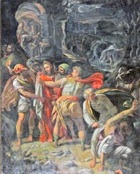


The Dominicans are first recorded in Spoleto in 1235, when the Blessed James of Bevagna joined their community. This was only a year after Pope Gregory IX had canonised St Domenic at Rieti: the Bull of canonisation had been issued from Spoleto.
San Salvatore
When the future St Peter Martyr preached in the city in 1245, he stayed with the friars and exhorted the citizens to establish a convent for them. In 1248, the papal legate, Raniero Capocci afforded them protection and arranged for them to be given a small church on this site. Traces of this church, which was dedicated to San Salvatore and belonged to San Pietro in Valle, remain under the present campanile.
[Fountain in what is now the Hotel san Luca]
San Domenico
Work on the present church began in 1251, the year in which the Dominican Fra. Orlandino preached in Spoleto in an attempt to bring peace to the city. Pope Alexander VI granted indulgences for those visiting it on the feasts of St Dominic and St Peter Martyr. The Dominican Bishop Paperonus De Paperonis (1285-90) probably encouraged the work on the church and convent, which was probably complete by the meeting of the Provincial Chapter that was held here in 1291.
The interior of the church was re-modeled in the Baroque style, presumably before its re-consecration by Bishop Lorenzo Castrucci in 1634.
Much of the convent was taken from the friars during the French occupation in 1789 and was subsequently used for various educational activities. The Dominicans were finally expelled in 1915 and the church passed to the Franciscans. It was restored in 1934-7 by Ugo Tarchi.
The church is now dedicated as SS Domenico e Francisco and is once more in the hands of the Dominicans.
Exterior
The church was faced with alternating bands of red and white marble.
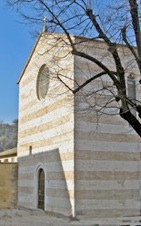
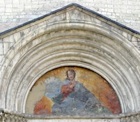
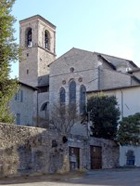
-
✴The upper section of the campanile also dates to the 16th century.
-
✴The chapels to the sides of the apse were added in the 17th century.
Interior
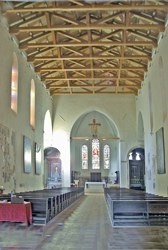
The programme of restoration of 1934-7 removed the Baroque decorations and revealed many of the original features, including a number of frescoes (14th and 15th centuries).
Counter-facade
Madonna and Child (14th century)
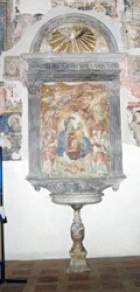
Left Wall
Communion of St Catherine of Siena (ca. 1461)
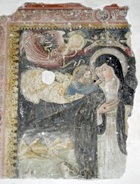
Cappella di San Pietro Martire (1679-80)
The original chapel here probably dates to 1391, when cult of St Peter Martyr was revived because he was deemed to have helped the Guelfs to victory against the Ghibellines at Ponte delle Torri. The Commune built its successor, which contains three panels (ca. 1700) depicting scenes from the life of St Peter Martyr. Two of these are set in Spoleto (one posthumously):
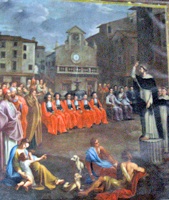
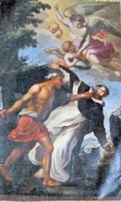
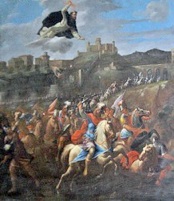
St Peter Martyr preaching Martyrdom of St Peter Martyr defeating
in Piazza del Mercato in 1245 St Peter Martyr the Ghibellines in 1391
at Ponte delle Torri
The paintings reproduced here show interesting images of Piazza del Mercato (before the present Fonte di Piazza was built) and Ponte delle Torri.
Pietà (15th century)
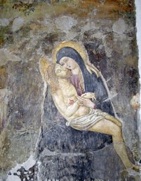
Left Transept
St Peter Martyr (14th century)
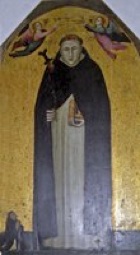
St Peter is shown against a gold background with a dagger in his shoulder while two angels hold a crown of martyrdom above his head. A small figure in the Dominican habit kneels to the right.
Cappella Benedetti (17th century)
Nicolò Benedetti di Montevecchio (died 1638) built this chapel, which houses his funerary monument on the right wall. The stucco decoration (1669) is signed as the work of Giovanni Fontana da Foligno.
The steps on the left of this chapel lead to the ex-church of San Pietro Martire, which originally had its own entrance.
Reliquary of the Sacro Chiodo (1726)
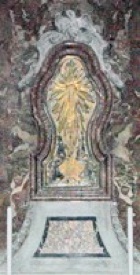
Frescoes (18th century)
The frescoes in the chapel, which are attributed to Liborio Coccetti, depict:
-
✴two scenes from the miracle of the “Sacro Chiodo” in the lunettes:
-
•an angel guides the Blessed Gregory of Spoleto to recover the relic; and
-
•a bishop cures a blacksmith by touching him with the relic; and
-
✴scenes from the Passion of Christ in the cupola:
-
•Christ nailed to the cross;
-
•the Crucifixion;
-
•the Pietà; and
-
•St Helena, the mother of the Emperor Constantine, throwing the sacred nail into the Adriatic to still a terrible storm that threatened to wreck the ship on which she returned to Italy from Jerusalem.
Capture of Christ (1574)
Apse
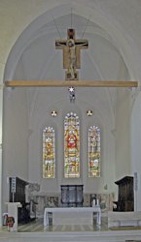
Crucifix (14th century)
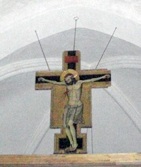
Frescoes (mostly 14th century)
These frescoes just above floor level include:
-
✴on the left:

-
•St Peter Martyr;
-
•the Madonna and Child enthroned; and
-
•the Pietà;
-
✴and on the right:

-
•St Peter Martyr (dated by inscription 142…); and
-
•the Madonna del Latte flanked by two female saints.
[Madonna and Child with SS Hyacinth and Brictius and souls in limbo - high up on the right]
Cappella Collicola
This chapel is to the right of the apse.
[Monument (17th century) to Taddeo Collicola, the doctor of Pope Urban VIII and founder of the family's fortunes.]
Cappella della Maddalena (15th century)
This chapel was built to the right of Cappella Collicola. The original frescoes (early 15th century) survive, although some are damaged. [Maestro dei Cavalari]
Christ in glory
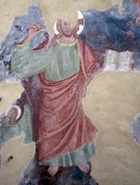
Crucifixion
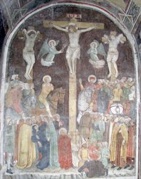
Scenes from the Life of St Mary Magdalene in Jerusalem

-
✴the raising of Lazarus (the brother of St Mary Magdalene); and
-
✴the "Noli me tangere" (illustrated), when the Risen Christ appeared to St Mary Magdalene but would not allow her to touch Him.
Scenes from the Life of St Mary Magdalene in Marseilles
These scenes depict:
-
✴the flight of St Mary Magdalene to Marseille, with St Maximinus (to who St Peter had entrusted her), the risen Lazarus and other companions (in the upper register of the left wall); and
-
✴St Mary Magdalene preaching in the city (in the upper register of the right wall).
Miracle of the Governor of Marseille
In this story from the "Golden Legend", St Mary Magdalene converted the Governor of Marseille and he then went on a pilgrimage to Rome. His wife died on the way and her grieving husband buried her on an island before continuing to Rome. There, St Peter told him to trust in God, and on his return journey, he duly found his wife alive in the place that he had left her body. When they arrived in Marseille, St Maximinus baptised them.
The cycle begins in the upper register of the right wall and then continues in the lower register of both walls.
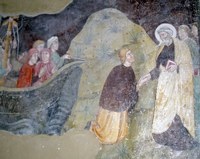
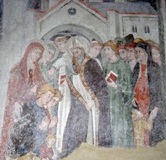
Prince of Marseilles meets St Peter St Maximinus baptises the
Prince and Princess at the behest
of St Mary Magdalene
Right Transept
Madonna and Child with saints (17th century)
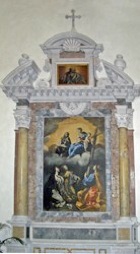
The main panel depicts the Madonna and Child in glory with St Anne and (below) SS Catherine of Siena, Catherine of Alexandria and Helen. The latter holds a large cross that the baby Jesus reaches towards.
The smaller upper panel, which depicts God the Father, is probably a workshop production.
Madonna and Child (15th century)
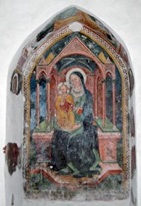
Panels (17th century)
Two panels in the transept are attributed to Francesco Refini:
-
✴Christ with SS Dominic and Catherine of Siena (ca. 1664), which was removed from the ceiling of the nave in 1934; and
-
✴the Madonna in glory with SS Hyacinth and Brictius.
Right Wall
Transfiguration (16th century)
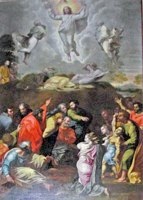
St Thomas Aquinas Enthroned (early 15th century)
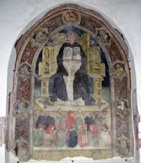
[Crucifix (14th century) attributed to the Maestro del Crocifisso di Visso]
